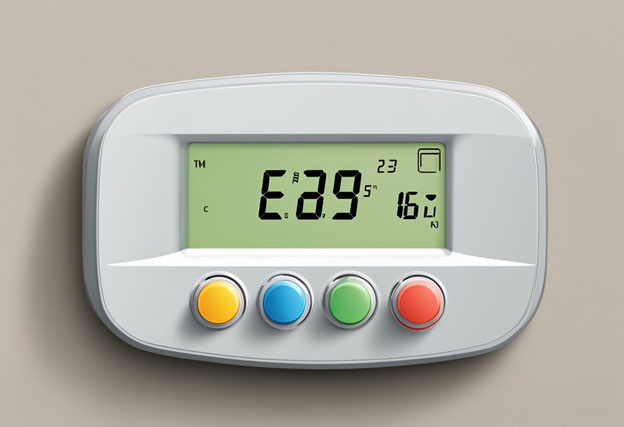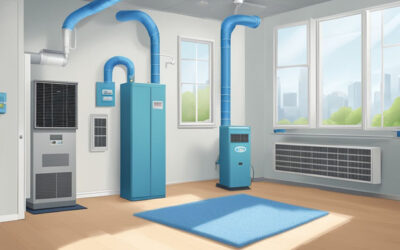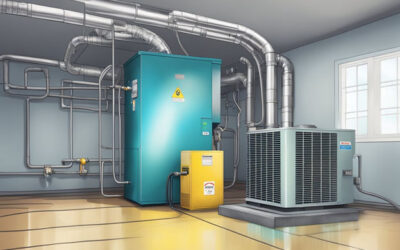Proper thermostat placement is an essential factor in maintaining a comfortable indoor environment. It is a common misconception that placing a thermostat anywhere in the house will provide accurate temperature readings. However, the placement of a thermostat can significantly affect the efficiency of the heating and cooling system.
The location of the thermostat can impact its ability to accurately measure the temperature of the room. For instance, placing a thermostat near a window or a door can result in inaccurate temperature readings due to drafts or direct sunlight. Similarly, placing a thermostat in a room that is not frequently used can lead to inefficient heating or cooling, as the thermostat may not accurately reflect the temperature of the rest of the house. Therefore, proper thermostat placement is crucial to ensure that the heating and cooling system runs efficiently and effectively.
In this article, we will explore the importance of proper thermostat placement and how it can affect the overall comfort and energy efficiency of a home. We will discuss the factors that can impact the accuracy of temperature readings and provide tips on where to place a thermostat for optimal performance. By understanding the importance of proper thermostat placement, homeowners can ensure that their heating and cooling systems are running efficiently and effectively, resulting in a more comfortable and energy-efficient home.
Fundamentals of Thermostat Placement
Optimal Temperature Sensing
Proper thermostat placement is essential for accurate temperature sensing and efficient heating or cooling. The thermostat should be installed on an interior wall, away from direct sunlight, drafts, and heat sources such as lamps or appliances. The ideal location is a central area where air can circulate freely, such as a hallway or living room.
It is also important to ensure that the thermostat is not obstructed by furniture or curtains, as this can affect the temperature readings. If the thermostat is too close to a door or window, it may also be affected by outdoor temperatures and give false readings.
Avoiding False Readings
False readings can occur if the thermostat is not properly placed or calibrated. For example, if the thermostat is located near a heat source, it may give a higher reading than the actual room temperature. This can cause the heating or cooling system to run longer than necessary, leading to wasted energy and higher bills.
To avoid false readings, it is recommended to have the thermostat calibrated by a professional and to follow the manufacturer’s instructions for proper placement. Regular maintenance and cleaning of the thermostat can also help ensure accurate temperature sensing and efficient operation.
In summary, proper thermostat placement is crucial for optimal temperature sensing and energy efficiency. By following the fundamentals of thermostat placement and avoiding false readings, homeowners can save money and reduce their environmental impact.
Impact on Energy Efficiency
Proper thermostat placement can have a significant impact on energy efficiency. By placing the thermostat in the right location, homeowners can reduce energy waste and improve HVAC performance.
Reducing Energy Waste
When a thermostat is placed in an area that is too warm or too cold, it can cause the HVAC system to work harder than necessary. This can lead to increased energy consumption and higher utility bills. By placing the thermostat in a central location, away from direct sunlight and drafts, homeowners can ensure that the temperature readings are accurate and that the HVAC system is only running when necessary.
Improving HVAC Performance
Proper thermostat placement can also improve the performance of the HVAC system. When the thermostat is located in a central area, it can better detect changes in temperature and adjust the system accordingly. This can lead to more efficient heating and cooling, as well as a longer lifespan for the HVAC system.
In addition to proper placement, homeowners can also improve energy efficiency by using a programmable thermostat. This type of thermostat allows homeowners to set different temperatures for different times of the day, which can help reduce energy waste and save money on utility bills.
Overall, proper thermostat placement is an important factor in improving energy efficiency and reducing energy waste. By taking the time to ensure that the thermostat is located in the right spot, homeowners can enjoy a more comfortable living environment while also saving money on their utility bills.
Considerations for Different Types of Thermostats
Programmable Thermostats
Programmable thermostats are a great option for those who want to save money on their energy bills. They allow you to set different temperatures for different times of the day, so you can lower the temperature while you’re away from home and have it warm up before you return. When it comes to placement, it’s important to install them in a central location away from any drafts or direct sunlight. This will help ensure that the temperature readings are accurate and that the thermostat is not affected by any external factors.
Smart Thermostats
Smart thermostats are the latest and greatest in thermostat technology. They can be controlled remotely through a smartphone app and can even learn your schedule and adjust the temperature accordingly. When it comes to placement, it’s important to install them in a central location away from any drafts or direct sunlight. Additionally, they should be placed in a location where they can pick up the most accurate readings from the surrounding environment.
Non-Programmable Thermostats
Non-programmable thermostats are the most basic type of thermostat and are typically found in older homes. They allow you to manually adjust the temperature, but do not have any advanced features like programmable or smart thermostats. When it comes to placement, it’s important to install them in a central location away from any drafts or direct sunlight. Additionally, they should be placed in a location where they can pick up the most accurate readings from the surrounding environment.
Overall, it’s important to consider the type of thermostat you have when deciding on placement. By installing your thermostat in the right location, you can ensure that it is working properly and that you are getting accurate temperature readings.
Factors Affecting Thermostat Placement
Proper thermostat placement is essential for maintaining a comfortable temperature in a home. There are several factors that affect the placement of a thermostat, including the home layout, sunlight and shade, and ventilation and drafts.
Home Layout
The layout of a home is an important factor to consider when deciding where to place a thermostat. Ideally, the thermostat should be located in a central area of the home, away from any sources of heat or cold air. This will help ensure that the temperature reading is accurate and reflects the overall temperature of the home.
Sunlight and Shade
Sunlight and shade can also affect thermostat placement. If the thermostat is located in an area that receives direct sunlight, it may give a false reading and cause the air conditioning or heating system to run more often than necessary. On the other hand, if the thermostat is located in a shaded area, it may not accurately reflect the temperature in the rest of the home.
Ventilation and Drafts
Ventilation and drafts can also impact thermostat placement. If the thermostat is located near a drafty window or door, it may give a false reading and cause the heating or cooling system to run more often than necessary. Additionally, if the thermostat is located near a vent or air duct, it may not accurately reflect the temperature in the rest of the home.
Overall, proper thermostat placement is essential for maintaining a comfortable temperature in a home. By considering factors such as home layout, sunlight and shade, and ventilation and drafts, homeowners can ensure that their thermostat is accurately reflecting the temperature of their home and running efficiently.
Installation Best Practices
Height and Level
The thermostat should be installed at a height that is easily accessible and readable for the user. It is recommended to install the thermostat at a height of 4-5 feet above the floor. Additionally, it is important to ensure that the thermostat is level during installation. An uneven installation can cause the thermostat to read an inaccurate temperature, leading to inefficient heating and cooling.
Wall Selection
The wall on which the thermostat is to be installed should be carefully chosen. It is important to avoid walls that are exposed to direct sunlight, drafts, or other sources of heat or cold. Such walls can cause the thermostat to read an inaccurate temperature and lead to inefficient temperature control.
Proximity to Air Vents
The thermostat should not be installed near air vents or other sources of airflow. This can cause the thermostat to read an inaccurate temperature and lead to inefficient heating and cooling. It is recommended to install the thermostat at least 3 feet away from any air vents or other sources of airflow.
Following these installation best practices can help ensure that the thermostat is installed properly and functions optimally.
Common Mistakes to Avoid
Placing Near Heat Sources
One of the most common mistakes people make when installing a thermostat is placing it near a heat source. This can cause the thermostat to read the temperature inaccurately and lead to inefficient heating and cooling. Heat sources can include anything from direct sunlight to lamps and appliances. It’s important to keep the thermostat away from these sources to ensure accurate temperature readings.
Obstructing Sensors
Another mistake people make is obstructing the sensors on the thermostat. Sensors are typically located on the back or bottom of the device and are responsible for measuring the temperature in the room. If they are covered or blocked by furniture or décor, the thermostat will not be able to accurately read the temperature. This can lead to over or under heating/cooling and wasted energy.
Ignoring Room Usage
Lastly, ignoring the room usage when placing a thermostat can also lead to inefficiency. For example, if a thermostat is placed in a room that is rarely used, it will not accurately reflect the temperature needs of the rest of the house. Additionally, if a thermostat is placed in a room that is frequently used, but the door is often closed, it will not accurately reflect the temperature needs of the rest of the house. It’s important to consider the usage of each room when deciding on thermostat placement.
By avoiding these common mistakes, homeowners can ensure their thermostat is accurately reading the temperature and operating efficiently.
Advanced Tips for Precision Control
Using Remote Sensors
For those who desire even more precise temperature control, the use of remote sensors can be a game-changer. Remote sensors can be placed in different areas of the home, allowing the thermostat to take readings from multiple locations and adjust the temperature accordingly. This is especially useful for larger homes with multiple floors or rooms that are difficult to heat or cool.
By using remote sensors, the thermostat can better understand the temperature needs of each area and adjust accordingly. For example, if the living room is consistently warmer than the rest of the house, the thermostat can adjust the temperature in that area without affecting other areas of the home. This can result in significant energy savings and increased comfort.
Zonal Temperature Balancing
Another advanced technique for precision control is zonal temperature balancing. This involves dividing the home into different zones and controlling the temperature in each zone independently. This can be done using multiple thermostats or a single thermostat with zoning capabilities.
Zonal temperature balancing can be especially useful for homes with varying temperature needs, such as those with a basement or attic. By controlling the temperature in each zone independently, the thermostat can ensure that each area is at the desired temperature without wasting energy on areas that don’t need it.
Overall, these advanced tips for precision control can help homeowners achieve greater comfort and energy savings. By using remote sensors and zonal temperature balancing, the thermostat can better understand the temperature needs of each area and adjust accordingly, resulting in a more comfortable and efficient home.





0 Comments